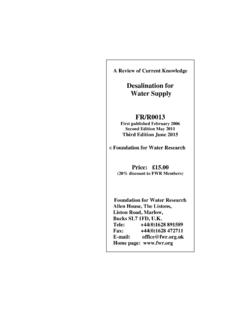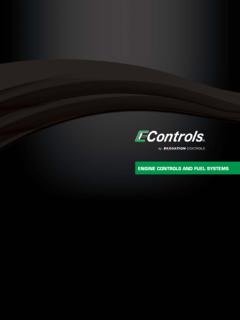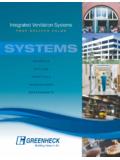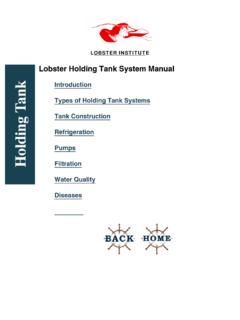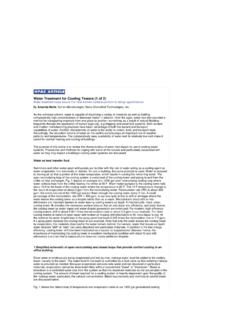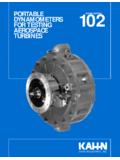Transcription of CAUSES OF COPPER CORROSION IN PLUMBING …
1 A Review of Current Knowledge CAUSES OF COPPER CORROSION IN PLUMBING SYSTEMS FR/R0007 Third Edition September 2017 Second Edition September 2010 First published February 2003 Foundation for Water Research Price: (20% discount to FWR Members) Foundation for Water Research Allen House, The Listons, Liston Road, Marlow, Bucks SL7 1FD, Tele: +44(0)1628 891589 Fax: +44(0)1628 472711 E-mail: Home page: Review of Current Knowledge Foundation for Water Research 2017 Copyright Apart from any fair dealing for the purposes of research or private study, or criticism or review, as permitted under the UK Copyright, Designs and Patents Act (1998), no part of this publication may be reproduced, stored or transmitted in any form or by any means, without the prior permission in writing of FWR.
2 Disclaimer Whilst every effort has been made to ensure accuracy FWR will not accept responsibility for any loss or damage suffered by any person acting or refraining from acting upon any material contained in this publication. Appropriate professional advice should be sought when making important decisions to ensure the information is correct, up-to-date and applicable to specific circumstances. This review is one of a series of Reviews Of Current Knowledge (ROCKs) produced by FWR. They focus on topics related to water supply, wastewater disposal and water environments, which may be the subject of debate and inquiry.
3 The objective of each review is to produce concise, independent scientific and technical information on the subject to facilitate a wider understanding of the issues involved and to promote informed opinion about them. Review of Current Knowledge 1 CAUSES OF COPPER CORROSION IN PLUMBING SYSTEMS Cover page image P Munn Author: Third Edition: Dr Phillip Munn Second Edition: Dr J J nsson First Edition: R J Oliphant Review of Current Knowledge 2 CONTENTS Forward 31 Introduction 32 Cuprosolvency and Blue Water 63 Erosion CORROSION 84 Type 1 Pitting 105 Flux Attack 126 Microbial Influenced CORROSION (MIC) 147 Type 2 Pitting 168 Under Deposit CORROSION 179 Rosette CORROSION in Hot Water Cylinders 1810 Formicary CORROSION of COPPER Pipes (External) 1811 Dezincification of Brass Fittings 2012 Stress CORROSION cracking of brass 2113 Further Reading23 Review of Current Knowledge 3 Forward This edition has been fully revised from the earlier 2003 and 2010 editions.
4 The aim of this publication is not to be an authoritative text book but rather to assist practitioners to diagnose the many different types of CORROSION failures, which can occur in COPPER PLUMBING systems and help to avoid them occurring. It is not meant to be a substitute for expert opinion in serious cases. The following covers failures which can occur in both hot and cold domestic water systems, not closed central heating systems. Although failures of COPPER and brass fittings can occur in central heating systems, they are extremely rare as the dissolved oxygen content of the water is normally insufficient to cause CORROSION . That is not to say that COPPER CORROSION failures are common in domestic (drinking) water systems.
5 Considering the hundreds of miles of COPPER pipework which is installed in the UK each year, the number of failures is quite low. 1 INTRODUCTION CORROSION of COPPER pipes and COPPER alloy fittings results in costly damages for owners of buildings, not only in terms of the replacement of pipework systems but also the consequential damages from leaks. Installers are often held responsible for these damages, although they may not themselves be directly to blame. Thankfully, the large majority of PLUMBING systems operate without any concerns and give a trouble-free long life. Problems of CORROSION of COPPER and COPPER alloys in PLUMBING systems occur when the protective COPPER CORROSION product layers either do not properly form in the first place or become disrupted during service for some reason.
6 This is usually down to a combination of adverse circumstances during installation, commissioning and service. The problems manifest themselves in either leaks or high COPPER levels and blue water. COPPER pipes can leak due to various forms of pitting attack or erosion CORROSION while COPPER alloys, especially brass fittings, can undergo dezincification or stress CORROSION cracking. Problems are far more likely to occur in large complex systems, such as those found in hospitals, hotels and large office buildings or country houses, where pipe runs are long and the hot water is distributed through a recirculating system . On the other hand, problems with COPPER CORROSION are rarely encountered in normal residential houses.
7 For instance, erosion CORROSION which may occur in large buildings with recirculating hot water systems virtually never happens in normal residential houses even if the water is fully softened. Where problems do occur in residential houses, it is more often than not in pipework to little-use en-suite bathrooms, where water stagnation occurs. Review of Current Knowledge 4 There are many different forms of pitting attack, which may result in leaks in COPPER pipes, such as Type 1 pitting; Type 2 pitting; microbiological influenced pitting CORROSION (MIC); flux attack; and under-deposit CORROSION . Most of these forms of pitting attack are very rare as are other phenomena such as rosette CORROSION of COPPER cylinders.
8 A plumber may spend his/her whole career without ever encountering some of these phenomena. Therefore, this guide will concentrate on the most common forms of attack and how they can be avoided. The above only refers to internal CORROSION of COPPER pipes and fittings. However, a form of external CORROSION of COPPER pipework called formicary CORROSION has resulted in costly leaks and the necessary replacement of pipework systems. This can occur under phenolic foam insulation due to the presence of moisture. Because it occurs under insulation or lagging and it results in very slow leakage of water, it often goes unnoticed until the pipework system has been too badly damaged for effective remediation.
9 Although this is something which only really affects large buildings, such as hospitals, the consequences can be severe, resulting in the wholesale replacement of the pipework system . What Normally Happens When COPPER pipes are first installed, they have a shiny metallic COPPER surface. On contact with aerated natural waters, COPPER ions will be released into the water due to CORROSION of the COPPER . However, in flowing aerated water, surface films formed of COPPER CORROSION products begin to form on the bore of the pipes, which quickly reduces the COPPER CORROSION rate and COPPER levels in the water. In cold waters of near neutral pH, the stable film formed is the cuprous oxide or COPPER (I) oxide [Cu2O], which in its pure state is ruby red but usually has a brown-black colour when formed on COPPER pipes.
10 In hot water systems, the black cupric oxide or COPPER (II) oxide [CuO] is more stable. On top of these layers a green malachite or COPPER hydroxy carbonate [Cu2 (OH)2CO3 ] layer will begin to form within a few days. Eventually, the bore of the COPPER pipe will be covered with a stable protective patina of COPPER oxides overlaid with a continuous COPPER hydroxy carbonate layer, as shown in Fig. 1. The COPPER CORROSION product layers, once properly formed, are normally stable, adherent and are relatively insensitive to changes in water composition and operating conditions. The COPPER pipework system can then go on to give a long trouble-free life, well in excess of 20 years.







